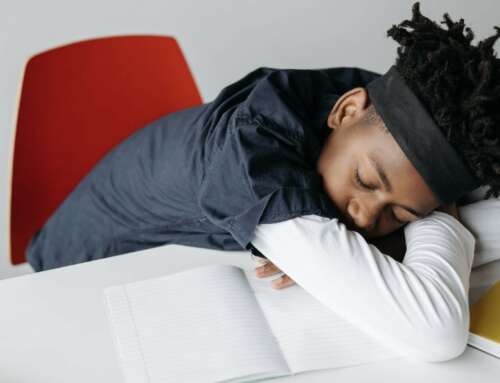What are some common behavioural sleep problems in children?
The most common issues are: not getting into bed; not settling into sleep; not staying in their own bed; waking up at night; getting up in the morning and / or not getting enough sleep.
What can you do to get your child into bed at the right time?
Set up a bedtime routine. Stick to it each night. Be consistent with it. This helps your child’s body and mind to get ready for bed. They will go to sleep more easily if they go to bed at about the same time each night. They are more likely to wake at about the same time each morning as well. Parents must always be ready to be firm if their child acts up around bedtime.
What is a bedtime routine?
It is best to start with a 30 to 60 minute quiet time. Keep your child away from computers, TVs and anything else that is too stimulating. It is normal to include a bath / shower, pyjamas, a drink, cleaning teeth, a toilet visit, a bedtime story, a goodnight kiss and then lights out as parents leave the bedroom. Put limits on what you let your child do here. Don’t let them stall for time. Make sure that lights are out at an appropriate time. This will give your child the sleep they need. The next day they are more likely to wake up refreshed and be better behaved.
How do you determine lights out time so your child gets enough sleep?
Lights out time depends on sleep need. It also depends on when they wake up. For example, if your child needs about 11 hours of sleep and has to wake up at 7am, then lights out would be at about 8pm.
Your child is finding it hard to go to sleep. What can you do?
- Make sure that your child prepares for bed in a way that helps them relax and feel ready for sleep. Think about what should and should not be in the bedroom. You want it to be a relaxing place.
- Make sure there are no noises that disturb your child’s sleep such as TV noise.
- Make sure your child can switch off their thinking after lights out. This will make settling into sleep easier. You can teach your child things such as simple breathing or relaxation exercises. These distract the mind and slow it down, so sleep can come. Quiet time with no technology before bed time will help. Soft quiet music may also help.
- Make sure that your child is not going to bed too early or too late. Both can make it hard to settle into sleep. Try to be aware of when your child gets sleepy in the evening. This will let you know when the sleep processes are starting to kick in. From this you can work out when the best time to go to bed is. Remember, as your child gets older their switch on for sleep will be a bit later. This means bedtime is a bit later too.
- Make sure that your child does not grow to need you to help them to go to sleep. They need to learn how to settle into sleep alone. (See question 7 below).
Why does your child keep waking you up during the night?
Your child can naturally several times a night. These disturbances last a few seconds to a few minutes. They should be able to self settle back into sleep. But if your child has not learned how to self settle, they may wake you or come to your bed to seek your help to go back to sleep. It’s worth teaching your child to self settle at the start of the night. This will help them to be able to self settle through the night. You will get a much better night’s sleep from this.
How can you teach your child to self settle into sleep?
- To teach them how to do this, you need to go out of the room with the lights out. You should do this before they are asleep. This gives them the chance to fall asleep with no help from you and when you’re not in the room with them. It usually takes 15 to 20 minutes for them to fully get to sleep. Try to avoid doing things in or around your child’s bedroom during this time.
- If your child has never gone to sleep without you, explain to them what is going to happen. Be firm but reassuring to your child about being able to go to sleep when you’re not in the room.
- Some children will get worried about this or try not to let you leave the room. Some will get out of bed to find you. In this case you can take things more slowly. You can go back into the room on and off, for a short time. If you need to, you can put them back into bed, get them to lie down and tell them to go to sleep. When this is done, you leave the room. You may need to do this over and over. Each time, spend longer and longer out of the room. If you are consistent and stick with this, then you will succeed. Remember to keep a lid on your emotions when in the bedroom. Also be as boring as possible.
- One more thing you can do is to put a stretcher bed or mattress next to your child’s bed. Be there, but have very little interaction with your child. The only thing you should do is tell them to go to sleep. Remember that this should only be a temporary thing. Once they are used to this they will go to sleep without being told to. Then you should start to gradually get out of the bedroom. It is important that once you start this not to give in. Don’t go back to old ways. This will confuse your child and make it harder the next time you try to change. You can also use this if they have been sleeping with you and you want to teach them to sleep in their own bed.
- You might find teaching your child to self settle into sleep is causing distress to you and your child. Or you might not be sure of what strategies to use. If so, it is recommended that you seek professional help. See a Sleep Specialists.
Are there other reasons why my child may wake up or stay awake at night?
After waking up at night, your child may find it hard to get back to sleep. This is due to their brain starting to think about things and keeping them awake. Your child may not tell you about this and lay awake in bed for some time. In the morning they can be hard to wake or still seem tired even though they had enough time in bed to get the sleep they need.
Remember to ask them in the morning if they had a good sleep. This lets them tell you if they have any problems with their sleep. Help them to learn how to deal with sleep problems. If necessary, see a Sleep Specialist.
There are other reasons why your child might wake up at night. These include illness, being too hot or cold, hunger, nightmares and sleep terrors.These tend to get better with time and don’t last. To learn how to deal with this see Nightmares and Sleep Terrors
What can you do if your child is anxious, is scared of the dark or has night-time fear about bedtime?
- A small dim night light can help. When your child wakes during the night, having some light helps them work out where they are and know they are safe. Taking a comfort object to bed, like a teddy bear, can help your child not feel so alone at night. Remember to reassure them that nothing will hurt them. Sometimes a baby monitor in their room (linked to you) will help.
How can you help your child to stay in their own bed?
- Be consistent and assertive about your child staying in their own bed. If you do not want them to sleep in your bed, always take them back to their own bed when they come to your bed. Remember to always remind them that you expect them to stay in their own bed all night.
- Build a consistent habit of your child going to sleep in the place where your child will sleep for the night. It is best if this is their own bed. It can be disturbing for them to wake up somewhere other than where they remember going to sleep. This can make them get out of bed and wake you.
- Remember to praise your child for successfully staying in their own bed all night. It can help to have a reward system if they behave well at bedtime. Keep the rewards small and frequent. Stickers often work well.
You can’t deal with your child’s sleeping problem. What can you do?
If you are not sure about why your child has a sleep problem or you can’t deal with it, contact your family doctor or paediatrician. Some children may need a Sleep Specialists If you feel your child may have a sleep disorder, please see the page on this topic, Childhood Behavioural Sleep Problems and Childhood Snoring and Sleep Apnea
– Sleep Health Foundation
Download the fact sheet here.
Image by Gregory Pappas from Unsplash







Leave A Comment